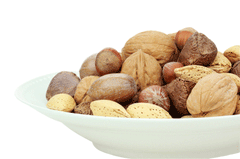
Omega 3's - are they worth those dollars? Are they really working?
I don't know about you, but we spend a good deal of money every month purchasing my omega-3 fatty acid capsules. I've read a lot about mercury and lead contamination and possible rancidity in the different capsules. So I was very excited and pleased to see that Consumer Lab has done a large analysis of all the potential benefits and whether or not they are real or just perceived. Are we just spending too much money on something that doesn't work? For that reason I wanted to share this information with you. I would, however, highly recommend that you purchase a very reasonably priced subscription from consumerlab.com because the extensive report they published covers far more than what I am able to cover in this blog.
What are Omega 3's?:
EPA and DHA are two principal fatty acids found primarily in fatty fish, krill and calamari. You are probably very familiar with the term omega-3 fatty acids. DHA can also be obtained from other sources such as algae. The body can only manufacture limited amounts of EPA and DHA from food as well as alpha linolenic acid (ALA) from plant foods such as flaxseed and walnuts. Consumer lab.com recently did an extensive analysis of the research concerning the benefits, which are many, of supplementing or consuming omega-3 fatty acids. Below you will find a list of the proposed benefits as well as the research that supports these benefits or has shown a lack of substantial justification for taking the supplement.
Heart attack and stroke:
The FDA has approved the labeling of supplements containing omega-3 fatty acids to state that research shows "supportive but not conclusive evidence that consuming DHA and EPA may reduce the risk of coronary heart disease." There is also an approved pharmaceutical prescription of a high-dose highly concentrated EPA/DHA product derived from fish oil. Heart healthy benefits attributed to omega-3 fatty acids include:
1. Reducing triglyceride levels
2. Raising levels of the good cholesterol (HDL),
3. Possibly thinning the blood
4. Reducing homocystine levels
5. And also reducing blood pressure.
Conclusion:
After a review of 14 studies Consumers Lab found no significant difference in outcomes between those who did from those who didn't take fish oil supplements.(1) Prior research has suggested a benefit for individuals with a history of cardiac disease. Clinical trials since 2010 now cast doubt on the benefit for both healthy individuals or those with prior cardiovascular vascular disease. However it was also stated that these studies may have been too short or small to detect small or modest benefit.(2) An additional review of twenty studies published from 1989 to 2012 also concluded that supplementing with omega-3 fatty acids was not associated with a lower risk of heart attack, stroke, cardiac death, sudden-death for all forms of death among people. It should be said that most of these participants in the studies were at increased cardiovascular risk and were probably taking cardiovascular medicatio.(3) However, one study looked specifically at cerebrovascular disease (strokes) and found benefit from fish oil supplementation as well as eating fish. Another analysis of thirty-eight studies found that eating two to four servings per week of fish resulted in a 6% lower risk of stroke compared to eating one or fewer servings per week.(4) It was believed that the decreased risk of stroke was seen with fatty fish types and not whitefish types and that the beneficial effects of eating fish could very well be due to a wide range of nutrients that are found in fish. So in conclusion, although it has been widely believed that supplementation with omega-3 fatty acids was beneficial in reducing cardiovascular events it does seem to remain generally not substantiated following the review of these studies. However, eating fish at least twice a week may be beneficial as long as it is not fried or deep fried.
Arthritis and other inflammatory diseases:
It is known that increased intake of omega-3 fatty acids from fish alters the body's production of prostaglandins and therefore reduces some forms of inflammation. Because of this fact, supplementation with EPA and DHA has been used for symptoms of rheumatoid arthritis and does seem to work in the early stages of the disease. However it was believed that fish oil probably doesn't slow progression of the disease. Because of its anti-inflammatory properties there have been other diseases with inflammatory components that have been studied and in one large study it was shown that people with the highest consumption of DHA had a 77% reduction in the risk of developing ulcerative colitis. (5)
Cancer:
After looking at studies regarding the prevention of cancer of the prostate, colon/rectum, and breast, it appeared that current use but not past use of fish oil supplements was associated with a 32% reduction in the risk of breast cancer. The risk reduction was more effective for ductal carcinoma of the breast than lobular carcinoma. It was suggested that the anticancer effects may be due to the anti-inflammatory property of fish oil because chronic inflammation is associated with cancer risk and progression. It was noted, however, that researchers felt fish oil cannot be recommended for breast cancer prevention without further study. An additional study did find fish consumption to be associated with a large reduction in late stage or fatal prostate cancer.(6)
Chemotherapy:
It was found fish oil could be helpful to prevent weight loss during cancer chemotherapy. Although not all studies did show this benefit a recent study showed significant benefit.(7)
Eye disease:
And analysis of the use of supplementation with omega-3 fatty acids did show that those with the highest intake of EPA and DHA were 30% less likely to develop diseases of the retina. Decreased risk of developing age-related macular degeneration was also shown in a study of over 30,000 female health professionals. Those who ate fish at least once a week had a 42% reduction in developing AMD compared to those eating less than one serving per month. It appeared that the greatest benefit was with consumption of canned tuna or other dark meat fish such as mackerel, salmon, and sardines.(7)
Psychiatric and mental disorders:
Omega-3 fatty acids appear to help mental disorders such as depression, bipolar disorder, and schizophrenia although there have only been a limited number of double-blind trials.
Depression:
In a study comparing depressed older women in a nursing home showed significant improvement and remission of 40.9% compared to 16.7% of those taking placebo.(8). The same study also showed a significant improvement in their self assessed quality-of life.
Suicide:
A study was done on military personnel who had committed suicide. Prior to suicide they had a significantly lower blood level of DHA than personnel who did not commit suicide.(9) It was found that in this mostly male population the risk of suicide was 62% greater among those with low serum levels of DHA compared to those with higher levels. As a side note the researchers found that omega-3 fatty acid levels were generally lower in the military personnel who participated in the study, in fact much lower, than in the general population.
Anxiety:
Using medical students in the United States for comparison, researchers found that those who received the high-dose omega-3 fatty acid showed a 20% reduction of anxiety symptoms compared to those receiving placebo treatment. They also noted that the students treated also had a 14% decrease in a marker of inflammation.(10) It should be noted however that the study used a very concentrated fish oil which was high in EPA because evidence points to EPA as having a relatively stronger anti-inflammatory and antidepressant effects than DHA.
Alzheimer's disease:
It has been shown in previous population studies the consumption of DHA is associated with reduced incidents of Alzheimer's disease. Animal studies also have demonstrated that DHA consumption reduces Alzheimer-like brain disease. It should be noted however that DHA from algae has not shown these same benefits even though plasma levels of DHA tripled and the amount of DHA in cerebrospinal fluid increased by 38%, meaning the DHA was absorbed. There was, however, no significant change from those taking placebo.
Age-related cognitive decline:
In contrast to Alzheimer's disease, age-related cognitive disease is not actually considered a disease but is more of a gradual declining of mental capacity and perhaps a normal consequence of aging. One study involving a small population of those 65 and over with mild cognitive impairment showed that those receiving a large amount of DHA with EPA had improved scores on verbal fluency, although not on any other memory or cognition test compared to those in a control group. The researchers rightfully noted that depression is a risk factor for progression to dementia so if there is a reduction in depressive symptoms this may also reduce the risk of dementia.
Memory enhancement in healthy individuals:
In one small study of healthy young adults, improved working memory performance was found to result with higher levels of DHA but not EPA. Participants were then asked to take higher concentrations of fish oil containing EPA and DHA daily for six months and they were tested again and scores improved.(10)
Strength training in older women:
Considering the fact that omega-3's have been shown to play a role in the plasma membrane and cell function of muscles, studies were done on mostly sedentary women in their mid 60s who were given supplements of fish oil containing both EPA and DHA. After 12 weeks of supervised lower body resistance training three times a week, the strength of those taking the fish oil had improved more than those who did not take the fish oil. It was also noted that what is referred to as functional capacity, assessing the speed of rising from a chair for instance, also increased more among those who took the fish oil. However simply taking fish oil without strength training did not show any benefit.(11)
Quality Control:
It's perhaps important to note that neither the FDA nor any other federal or state agency is responsible for or actually does routine tests on fish oil supplements for quality prior to being placed on the market. For this reason consumerlab.com chose to independently evaluate omega-3 products on the market today that claim to contain EPA and or DHA. They proceeded to test them for the levels of omega-3 fatty acids as indicated on their labels (EPA, DHA and, if listed, ALA), mercury, lead, PCBs, and signs of decomposition. An abbreviated list of the quality concerns and the issues that consumer lab tested for follows below:
Contamination:
Contamination has always been an issue because fish can accumulate toxins such as mercury, dioxins, and PCBs. Mercury is also a well-known element that can damage the nervous system and is particularly dangerous in a fetus. Dioxins and PCBs may be carcinogenic even at low levels of exposure over time and may also have other harmful effects.
Freshness:
The freshness of an oil is always an important consideration because fish oil can go rancid resulting in an unpleasant odor and taste. More importantly than odor or taste is the fact that rancid fish oils can produce a variety of compounds, some of which could cause health concerns. A study by the government of Norway concluded that there would be some health concerns related to the regular consumption of rancid fish/marine oils particularly in regards to the gastrointestinal tract. However there's not enough data to determine the amount of risk.(12)
In conclusion:
Whew! I know this has been a long blog, but an important one I think. Consumer Lab found that of the 35 products they selected for review only 24 passed quality testing for meeting requirements for freshness, purity, and if they contained the declared amounts of omega-3 fatty acids. If the supplement had any enteric coatings they tested to see if they were properly absorbed. Considering all the various and important potential benefits of supplementing with omega-3 fatty acids and or eating fatty fish, it seems to me that it would be advantageous to read the full report that Consumer Lab published. There was in this report detailed discussion of all the varieties and ways you may be spending your money on a product that is not effective and even potentially harmful. In this report they also talk individually about each of the products they tested and why they were or were not approved. It is an extensive list of specific brand names and shows an analysis of prices, some of which are ridiculously expensive with "very low concentration" of Omega 3's. This list also shows what you are actually getting for those diminishing dollars in terms of the actual concentration of DHA and EPA. This is an important discussion because there is much confusion in this area. My husband and I have spent many hours looking at the various labels with our calculators in hand. This is no longer necessary with this excellent comparison done for you. Obviously, I'm not going to list the brands they analyzed, but just as an example, Dr. Mercola's very expensive Krill Oil was analyzed as containing a "very low" concentration of Omega 3's and at a very high cost. As a matter of fact, most of the krill oil supplements showed low to moderate levels of concentration, and these are usually more expensive. So, if you don't take Omega 3 fish oil or eat fatty fish on a regular basis, I suggest that you do. If you want to be sure that you are purchasing the best for the dollar, then spend that $33 for a one-year subscription to Consumerlab.com. No - they aren't paying me for this recommendation. They have no idea I exist other than perhaps in their record keeping as I purchase their subscription every year.
Do you take Omega 3's? If you are a vegetarian, do you find that the ALA in plant-based foods is sufficient? How much do you spend on your supplements and where do you purchase them? Can you tell a difference when you don't take them. I can - both from an inflammatory and vascular standpoint. I can also tell from one brand to another. Trader Joe's didn't work - for me anyway.
Thanks for listening!

1. Kwak S, Myung S, Lee Y, Seo H, Korean Meta-analysis Study Group f. Efficacy of Omega-3 Fatty Acid Supplements (Eicosapentaenoic Acid and Docosahexaenoic Acid) in the Secondary Prevention of Cardiovascular Disease: A Meta-analysis of Randomized, Double-blind, Placebo-Controlled Trials. Arch Intern Med. 2012;172(9):686-694. doi:10.1001/archinternmed.2012.262.
2. Hu FB, Manson JE. Omega-3 Fatty Acids and Secondary Prevention of Cardiovascular Disease—Is It Just a Fish Tale?: Comment on “Efficacy of Omega-3 Fatty Acid Supplements (Eicosapentaenoic Acid and Docosahexaenoic Acid) in the Secondary Prevention of Cardiovascular Disease”. Arch Intern Med. 2012;172(9):694-696. doi:10.1001/archinternmed.2012.463.
3. Rizos EC, Ntzani EE, Bika E, Kostapanos MS, Elisaf MS. Association Between Omega-3 Fatty Acid Supplementation and Risk of Major Cardiovascular Disease Events: A Systematic Review and Meta-analysis. JAMA. 2012;308(10):1024-1033. doi:10.1001/2012.jama.11374.
4. Chowdhury R, Stevens S, et al, Association between fish consumption, long chain omega 3 fatty acids, and risk of cerebrovascular disease: systemic review and meta-analysis: BMJ 2012;345:e6698.
5. Hart 2009.
6. Szymanski KM, Wheeler DC, Mucci LA.Fish consumption and prostate cancer risk: a review and meta-analysis:
Am J Clin Nutr. 2010 Nov;92(5):1223-33. doi: 10.3945/ajcn.2010.29530. Epub 2010 Sep 15.
7. Christen WG, Schaumberg DA, Glynn RJ, Buring JE. Dietary ω-3 Fatty Acid and Fish Intake and Incident Age-Related Macular Degeneration in Women. Arch Ophthalmol. 2011;129(7):921-929. doi:10.1001/archophthalmol.2011.34.
8. Rondanelli M, Giacosa A, Opizzi A, et al. Effect of Omega-3 Fatty Acids Supplementation on Depressive Symptoms and on Health-Related Quality of Life in the Treatment of Elderly Women with Depression: J Am Coll Nutr February 2010 vol. 29 no. 1 55-64.
9. Lewis M, Hibbeln J, Johnson J, et al. Suicide Deaths of Active-Duty US Military and Omega-3 Fatty-Acid Status: A Case-Control Compariso: J Clin Psychiatry 2011;72(12):1585-1590
10. Narendran R, Frankle WG, Mason NS, et al. Improved working memory but no effect on striatal vesicular monoamine transporter type 2 after omega-3 polyunsaturated fatty acid supplementation: PLoS One. 2012;7(10):e46832. doi: 10.1371/journal.pone.0046832. Epub 2012 Oct 3.
11. Rodacki C, Rodacki A, Pereira G, et al. Fish oil supplementation enhances the effects of strength training in elderly women: Am J Clin Nutr February 2012 ajcn.021915.
12. Torkildsen Ø, Wergeland S, Bakke S, et al. ω-3 Fatty Acid Treatment in Multiple Sclerosis (OFAMS Study): A Randomized, Double-Blind, Placebo-Controlled Trial. Arch Neurol. 2012;69(8):1044-1051. doi:10.1001/archneurol.2012.283.































